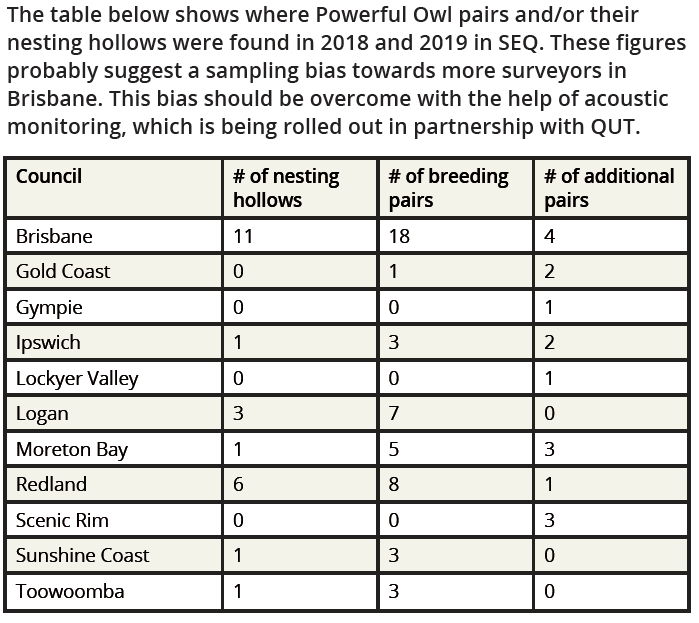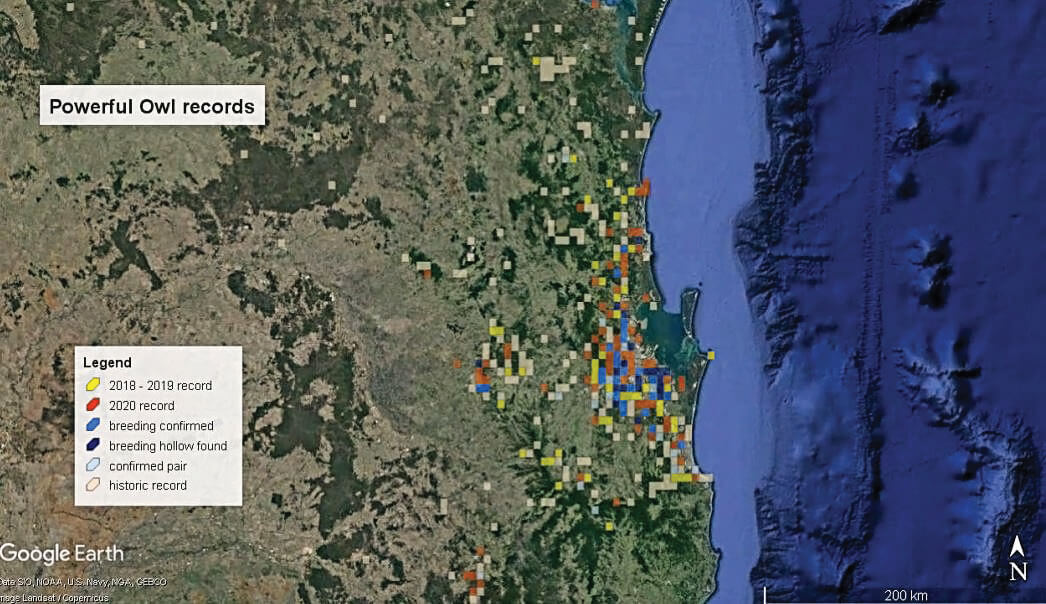In the forests of eastern Australia, apex predators hunt in the night on silent wings. Their large yellow eyes and sharp talons snatch up mostly arboreal prey of possums, gliders, flying foxes and sometimes birds. In urban situations there are records of them taking animals from the ground such as rabbits, rats and even a cat. Over the last three years, the Powerful Owl citizen science project, coordinated by Dr Robert Clemens at BirdLife Australia, has greatly expanded our understanding of this cryptic species in SEQ.
Like all owls, Powerful Owls hunt at night. Research on a male owl fitted with a radio-tracking device showed that they can fly up to 10km per night to hunt. During the day, they roost in dense vegetation, often along creeklines, where it is well protected and cooler. They often hold the remains of the previous night’s hunt in their huge yellow talons.

Powerful Owls are Australia’s largest owl with males being up to 65cm tall. Hence, it follows that they also require large tree hollows for breeding. These large hollows generally only occur in old-growth mature eucalypts trees that are 100-500 years old. Despite installations of many nest boxes designed for Powerful Owls, they have only ever successfully bred once in a nest box (to which they never returned to again). They simply don’t seem to use available nest boxes.
Powerful Owls mate for life and pairs defend their territory year-round. The size of a Powerful Owl territory ranges from 310 to 4740ha, depending on habitat and abundance of prey. If there is lots of food available and good breeding habitat (large hollows), Powerful Owls can occur in high densities. The highest know density is near Sydney with two pairs of owls only 500m apart.
Thanks to data collected from the Powerful Owl citizen science project, we know that there are at least 70 Powerful Owl pairs in SEQ. Breeding success over the past three years ranges from 0.8-1.35 chicks produced per nest, so the population seems to be steady. Across SEQ, only 31 breeding hollows have been located indicating the difficulty in finding active nests and also the paucity of suitable breeding hollows left in SEQ.

The threats to urban Powerful Owls differ to their counterparts living in remote areas. Electrocution on powerlines and vehicle strikes killed at least five Powerful Owls in SEQ in 2018. If Powerful Owls start to eat more ground-based prey in urban areas, it is a concern that they may be affected by secondary poisoning from rodenticides. This is already a huge problem for other owls that primarily prey on mice and rats (see facing page).
The 2019-20 fire season hit forest owls hard. About 31% of Powerful Owl habitat in Australia was burnt. These fires were a game-changer for forest ecology in eastern Australia and will affect forest dependent species, like Powerful Owls, for decades to come. Even if adult birds survived, their large breeding trees may have been lost and prey numbers depleted. It is terribly sad.
The Powerful Owl citizen science project in SEQ has involved thousands of volunteers. Over 500 people have been trained in the identification, monitoring and reporting of Powerful Owls. The project will run for a couple more years and you can join at any time. All trainees learn how to identify male and female Powerful Owls by appearance and by their calls. Adults will start calling soon in March and April as they set up their territories.
If you have seen or heard Powerful Owls, your data is valuable.
To learn more or join the project visit www.facebook.com/The Powerful Owl Project or birdlife.org.au/projects
Article by Fflur Collier
Land for Wildlife Officer
Brisbane City Council
View Full Newsletter

I have just spotted a pair of Powerfull Owls in a tree in Princess Street,Cleveland,Qsld,4 Feb 2025 at 3.15pm.
Hi Malcolm. You may wish to post such sightings on iNaturalist – it’s free and easy to use.